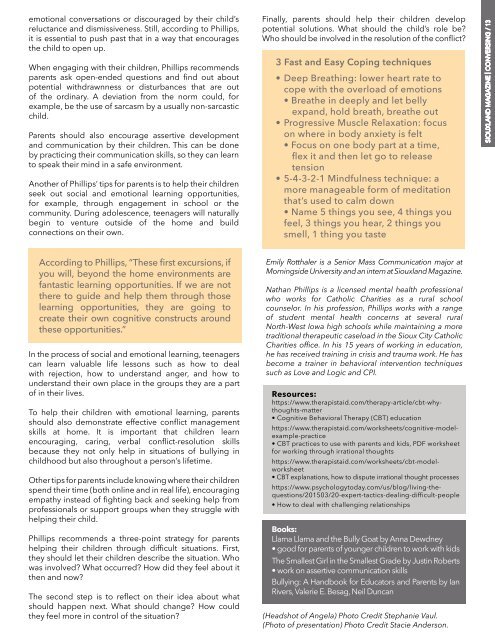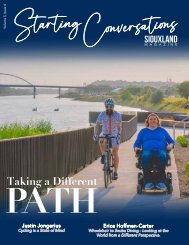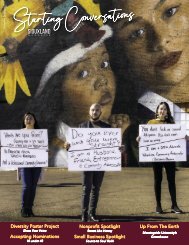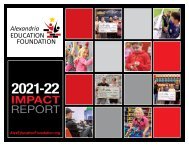Siouxland Magazine - Volume 4 Issue 6
Create successful ePaper yourself
Turn your PDF publications into a flip-book with our unique Google optimized e-Paper software.
emotional conversations or discouraged by their child’s<br />
reluctance and dismissiveness. Still, according to Phillips,<br />
it is essential to push past that in a way that encourages<br />
the child to open up.<br />
When engaging with their children, Phillips recommends<br />
parents ask open-ended questions and find out about<br />
potential withdrawnness or disturbances that are out<br />
of the ordinary. A deviation from the norm could, for<br />
example, be the use of sarcasm by a usually non-sarcastic<br />
child.<br />
Parents should also encourage assertive development<br />
and communication by their children. This can be done<br />
by practicing their communication skills, so they can learn<br />
to speak their mind in a safe environment.<br />
Another of Phillips’ tips for parents is to help their children<br />
seek out social and emotional learning opportunities,<br />
for example, through engagement in school or the<br />
community. During adolescence, teenagers will naturally<br />
begin to venture outside of the home and build<br />
connections on their own.<br />
Finally, parents should help their children develop<br />
potential solutions. What should the child’s role be?<br />
Who should be involved in the resolution of the conflict?<br />
3 Fast and Easy Coping techniques<br />
• Deep Breathing: lower heart rate to<br />
cope with the overload of emotions<br />
• Breathe in deeply and let belly<br />
expand, hold breath, breathe out<br />
• Progressive Muscle Relaxation: focus<br />
on where in body anxiety is felt<br />
• Focus on one body part at a time,<br />
flex it and then let go to release<br />
tension<br />
• 5-4-3-2-1 Mindfulness technique: a<br />
more manageable form of meditation<br />
that’s used to calm down<br />
• Name 5 things you see, 4 things you<br />
feel, 3 things you hear, 2 things you<br />
smell, 1 thing you taste<br />
<strong>Siouxland</strong> <strong>Magazine</strong> | Conversing / 13<br />
According to Phillips, “These first excursions, if<br />
you will, beyond the home environments are<br />
fantastic learning opportunities. If we are not<br />
there to guide and help them through those<br />
learning opportunities, they are going to<br />
create their own cognitive constructs around<br />
these opportunities.”<br />
In the process of social and emotional learning, teenagers<br />
can learn valuable life lessons such as how to deal<br />
with rejection, how to understand anger, and how to<br />
understand their own place in the groups they are a part<br />
of in their lives.<br />
To help their children with emotional learning, parents<br />
should also demonstrate effective conflict management<br />
skills at home. It is important that children learn<br />
encouraging, caring, verbal conflict-resolution skills<br />
because they not only help in situations of bullying in<br />
childhood but also throughout a person’s lifetime.<br />
Other tips for parents include knowing where their children<br />
spend their time (both online and in real life), encouraging<br />
empathy instead of fighting back and seeking help from<br />
professionals or support groups when they struggle with<br />
helping their child.<br />
Phillips recommends a three-point strategy for parents<br />
helping their children through difficult situations. First,<br />
they should let their children describe the situation. Who<br />
was involved? What occurred? How did they feel about it<br />
then and now?<br />
The second step is to reflect on their idea about what<br />
should happen next. What should change? How could<br />
they feel more in control of the situation?<br />
Emily Rotthaler is a Senior Mass Communication major at<br />
Morningside University and an intern at <strong>Siouxland</strong> <strong>Magazine</strong>.<br />
Nathan Phillips is a licensed mental health professional<br />
who works for Catholic Charities as a rural school<br />
counselor. In his profession, Phillips works with a range<br />
of student mental health concerns at several rural<br />
North-West Iowa high schools while maintaining a more<br />
traditional therapeutic caseload in the Sioux City Catholic<br />
Charities office. In his 15 years of working in education,<br />
he has received training in crisis and trauma work. He has<br />
become a trainer in behavioral intervention techniques<br />
such as Love and Logic and CPI.<br />
Resources:<br />
https://www.therapistaid.com/therapy-article/cbt-whythoughts-matter<br />
• Cognitive Behavioral Therapy (CBT) education<br />
https://www.therapistaid.com/worksheets/cognitive-modelexample-practice<br />
• CBT practices to use with parents and kids, PDF worksheet<br />
for working through irrational thoughts<br />
https://www.therapistaid.com/worksheets/cbt-modelworksheet<br />
• CBT explanations, how to dispute irrational thought processes<br />
https://www.psychologytoday.com/us/blog/living-thequestions/201503/20-expert-tactics-dealing-difficult-people<br />
• How to deal with challenging relationships<br />
Books:<br />
Llama Llama and the Bully Goat by Anna Dewdney<br />
• good for parents of younger children to work with kids<br />
The Smallest Girl in the Smallest Grade by Justin Roberts<br />
• work on assertive communication skills<br />
Bullying: A Handbook for Educators and Parents by Ian<br />
Rivers, Valerie E. Besag, Neil Duncan<br />
(Headshot of Angela) Photo Credit Stephanie Vaul.<br />
(Photo of presentation) Photo Credit Stacie Anderson.

















